| << Chapter < Page | Chapter >> Page > |
View this demonstration to see three weights that are connected by strings over pulleys and tied together in a knot. You can experiment with the weights to see how they affect the equilibrium position of the knot and, at the same time, see the vector-diagram representation of the first equilibrium condition at work.
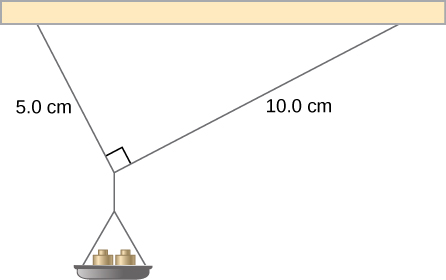
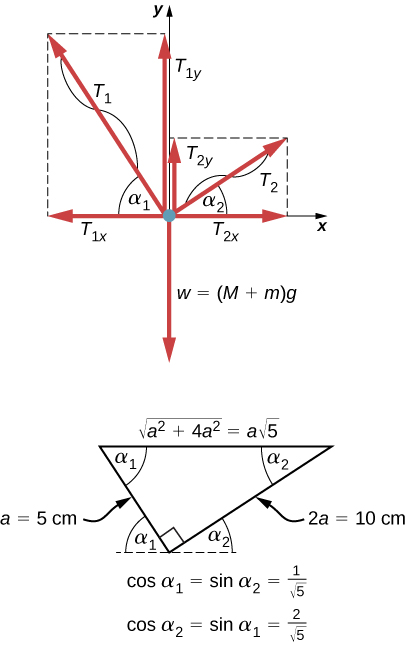
From the free-body diagram, the magnitudes of components in these equations are
We substitute these components into the equilibrium conditions and simplify. We then obtain two equilibrium equations for the tensions:
The equilibrium equation for the x -direction tells us that the tension in the 5.0-cm string is twice the tension in the 10.0-cm string. Therefore, the shorter string will snap. When we use the first equation to eliminate from the second equation, we obtain the relation between the mass on the pan and the tension in the shorter string:
The string breaks when the tension reaches the critical value of The preceding equation can be solved for the critical mass m that breaks the string:
What can you say about the velocity of a moving body that is in dynamic equilibrium?
constant
Under what conditions can a rotating body be in equilibrium? Give an example.
What three factors affect the torque created by a force relative to a specific pivot point?
magnitude and direction of the force, and its lever arm
Mechanics sometimes put a length of pipe over the handle of a wrench when trying to remove a very tight bolt. How does this help?
For the next four problems, evaluate the statement as either true or false and explain your answer.
If there is only one external force (or torque) acting on an object, it cannot be in equilibrium.
True, as the sum of forces cannot be zero in this case unless the force itself is zero.
If an object is in equilibrium there must be an even number of forces acting on it.
If an odd number of forces act on an object, the object cannot be in equilibrium.
False, provided forces add to zero as vectors then equilibrium can be achieved.
A body moving in a circle with a constant speed is in rotational equilibrium.
What purpose is served by a long and flexible pole carried by wire-walkers?
It helps a wire-walker to maintain equilibrium.
When tightening a bolt, you push perpendicularly on a wrench with a force of 165 N at a distance of 0.140 m from the center of the bolt. How much torque are you exerting relative to the center of the bolt?
When opening a door, you push on it perpendicularly with a force of 55.0 N at a distance of 0.850 m from the hinges. What torque are you exerting relative to the hinges?
Find the magnitude of the tension in each supporting cable shown below. In each case, the weight of the suspended body is 100.0 N and the masses of the cables are negligible.

What force must be applied at point P to keep the structure shown in equilibrium? The weight of the structure is negligible.
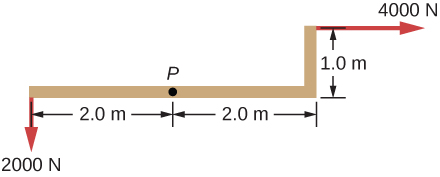
153.4°
Is it possible to apply a force at P to keep in equilibrium the structure shown? The weight of the structure is negligible.
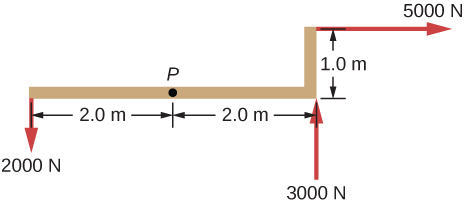
Two children push on opposite sides of a door during play. Both push horizontally and perpendicular to the door. One child pushes with a force of 17.5 N at a distance of 0.600 m from the hinges, and the second child pushes at a distance of 0.450 m. What force must the second child exert to keep the door from moving? Assume friction is negligible.
23.3 N
A small 1000-kg SUV has a wheel base of 3.0 m. If 60% if its weight rests on the front wheels, how far behind the front wheels is the wagon’s center of mass?
The uniform seesaw is balanced at its center of mass, as seen below. The smaller boy on the right has a mass of 40.0 kg. What is the mass of his friend?
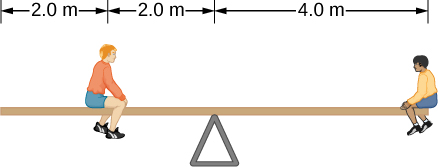
80.0 kg

Notification Switch
Would you like to follow the 'University physics volume 1' conversation and receive update notifications?